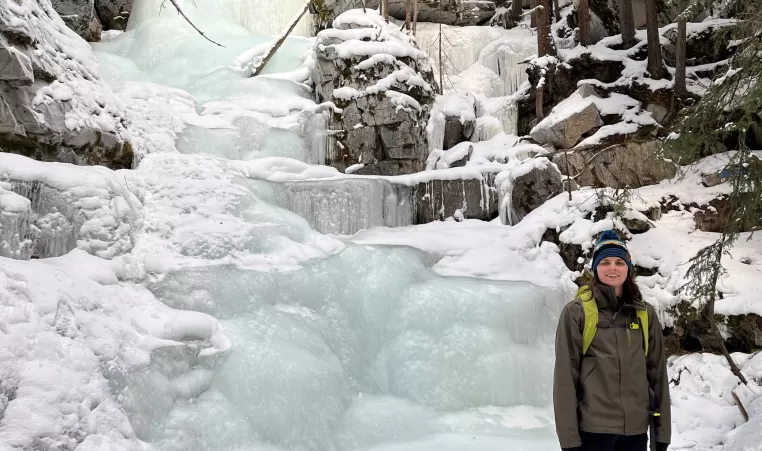
Kyla Jackson, Aquatic Supervisor at Remington YMCA in Quarry Park, is an avid hiker whose initiated a quarterly staff hike to engage YMCA employees and volunteers outside of work in some healthy, outdoor fun. For this month's staff feature, we wanted to share some of Kyla's tips for safe, fun (and warm) winter hiking.
Winter hiking is an excellent opportunity to see the world your familiar with from a very different perspective. The scenery surrounding a trail is different when covered in snow, there are way fewer crowds, it provides an opportunity to get out for some fresh air when it’s cold and best of all, there aren’t any pesky bugs.
Winter hiking does provide its own unique challenges compared to summer hiking, and therefore precautions are needed to have a safe and fun hike.
When packing for winter hiking it is important to dress in layers. A long sleeve merino wool base layer is a great place to start, combined with a mid-layer like a fleece or puffy jacket and a waterproof outer layer to wrap everything up.
It is also recommended to bring an additional layer in your pack in case your base layers get wet, it becomes colder than expected or in case of an emergency that will require you or your group to stay in place for an extended period of time. By wearing multiple layers you can add and remove them based on how warm you are feeling. Once you are moving you will build up a lot of heat and need to shed layers into your pack to avoid getting to hot and sweating. On the other hand, once you stop moving your body will start to lose heat quickly and it's much harder to get warm than it is to stay warm.
For your footwear you can go with boots or shoes, whichever you prefer but just make sure they are waterproof you have warm socks to keep your feet warm. A spare pair of dry socks in your bag also comes in handy if your feet get wet, and you need to change.
What should be in your pack? Your pack should contain some form of the following:
- Mirco spikes or similar traction aid: trail conditions can vary from dirt, to mud, to snow, to ice and everything in between so having additional traction for those slippery conditions is a must.
- Sunscreen/SPF lip balm: the snow can reflect up to 80% of the suns UV rays meaning you’ll receive almost twice as much exposure compared to when the ground is dry. This means sunscreen is a must, apply early and reapply often.
- Toe or hand warmers: if you are someone that tends to get cold toes or hands, having some of these ready to go can make a huge difference in keeping you comfortable and happy.
- Water: all that dry winter air can dry you out very quickly. Staying hydrated will help you stay warm so bring more water than you think you might need.
- Headlamp: It gets dark faster in the winter. If you take a wrong turn or get lost on the trail, you could find yourself in the pitch black before you know it. A powerful headlamp could make a drastic difference in this scenario.
- Food: food is fuel and fuel will help keep us warm and moving. Pack whatever you might normally bring on a hike but keep in mind that some foods handle being frozen better than others. Pack more than you think you need, if your hike takes longer than planned you will have enough to get through.
- First aid supplies: the winter can be harsh and unforgiving so pick up a small first aid kit that includes an emergency blanket or bivy to use in the event of an emergency.
Start small and be patient. Winter hiking is much slower than summer hiking, so plan extra time for your day and remember that the sun sets early and when it does, it can get cold fast. Start with easier hikes on familiar routes until you are comfortable and can venture out onto new trails. Always tell a friend or family member where you are going and when you plan to be back so they can inform search and rescue if there is an emergency. Most importantly, have fun!
Thank you Kyla for sharing your winter hiking insight with us!